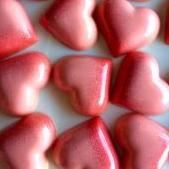I've skimmed through the threads in this forum on how to cast and attach a double mold together, but I didn't come across any pics of this process. Having never done this before, I don't really know where to start. Is the process different if the chocolate is filled vs. empty? It seems that if it's filled, you could cast both molds, then fill ganache to the tops of each mold and scrape, and then attach the molds together while the ganache is still "wet". But if the chocolate was empty (no filling), I would think that after casting the second mold, you'd have to attach it right away to the first so you still had a "wet" surface that would adhere. Does any of this make sense?!!
Next, it looks like there are several ways to attach your molds: (a) Metal clamps; (b) Plastic clamps; (c) Rubber bands; (d) Chopsticks
The metal and plastic clamps look like bizarro torture devices. How many of them do you use? I would guess 4, but would it be true that if you use more clamps, you'd get a tighter the seal and less of a seam? (btw- I'm talking about molds that are flat across the surface and don't have a raised lip like some egg molds out there). Thanks!





